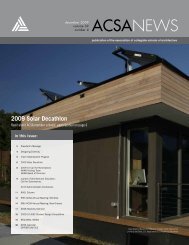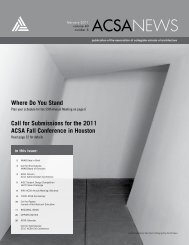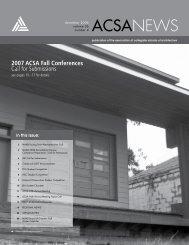digital aptitudes - Association of Collegiate Schools of Architecture
digital aptitudes - Association of Collegiate Schools of Architecture
digital aptitudes - Association of Collegiate Schools of Architecture
You also want an ePaper? Increase the reach of your titles
YUMPU automatically turns print PDFs into web optimized ePapers that Google loves.
SATURDAY, MARCH 3, 2012 - 12:30PM - 2:00PM<br />
Technology<br />
“S<strong>of</strong>t” Kinetic Network (SKiN)<br />
Vera Parlac, University <strong>of</strong> Calgary<br />
Richard Cotter, University <strong>of</strong> Calgary<br />
Todd Freeborn, University <strong>of</strong> Calgary<br />
Adam Onulov, University <strong>of</strong> Calgary<br />
The SKiN project consists <strong>of</strong> small scale prototypes <strong>of</strong> an adaptive<br />
kinetic surface capable <strong>of</strong> spatial modulation and response to<br />
environmental stimuli. The emphasis is on the nature <strong>of</strong> material<br />
systems in the built environment and their capacity for change and<br />
adaptation. Elements, structure, surface and performance <strong>of</strong> the<br />
developed networked kinetic material system are designed as integrated<br />
layers that make up a “tissue” capable <strong>of</strong> accommodating<br />
dynamic nature <strong>of</strong> human occupation.<br />
The “S<strong>of</strong>t” Kinetic Network (SKiN) surface is organized around<br />
the network <strong>of</strong> embedded “muscle” wires that change shape under<br />
electric current. The network <strong>of</strong> wires provides for a range <strong>of</strong><br />
motions and facilitates surface transformations through s<strong>of</strong>t and<br />
muscle like movement. The material system developed around the<br />
wire network is variable and changes its thickness, stiffness, or permeability<br />
within its continuous composite structure. The variability<br />
in the material system enables it to behave differently within surface<br />
regions; to vary the speed and degree <strong>of</strong> movement; to vary<br />
surface transparency; to enable other levels <strong>of</strong> performance such<br />
as capture <strong>of</strong> heat produced by the muscle wire and distribution<br />
<strong>of</strong> heat within the surface regions. The main idea is that variability<br />
<strong>of</strong> the material system can bring us closer to the seamless material<br />
integration found in biological organisms.<br />
Our focus on seamless material integration and capturing <strong>of</strong> emitted<br />
energy hints at our broader goal that architectural intervention<br />
should find a more productive place within larger ecologies.<br />
We are very much interested in suspending a challenge <strong>of</strong> finding<br />
a non-permeable and clearly defined boundary between inside<br />
and outside in exchange for a surface that fosters constant flow<br />
<strong>of</strong> information, matter and energy. One possible application <strong>of</strong> the<br />
SKiN is to provide a heated surface/street furniture/structure that<br />
is capable <strong>of</strong> mediating environment in cold climates in order to<br />
make outdoor public spaces active year-round. The Skin Surface<br />
has capacity to register weather conditions as well as number <strong>of</strong><br />
people around the structure and to adjust accordingly. Energy that<br />
structure uses to adjust its shape to the climatic conditions is captured<br />
and transferred into heat that in return mediates temperature<br />
around/on/below the surface.<br />
The developed SKiN prototypes are part <strong>of</strong> an ongoing research<br />
project in responsive systems in architecture. It is driven by an interest<br />
in adaptive systems in nature and a desire to explore the<br />
capacity <strong>of</strong> built spaces to respond dynamically and adapt to<br />
changes in the external and internal environment. “Smart” systems<br />
(sensors, actuators, and controllers) and kinetic parts (movable<br />
architectural components) are embedded into surfaces to enable<br />
spaces we inhabit (homes, workplaces, streets) to sense, respond<br />
and interact with us. The goal is to develop technologies and designs<br />
that are capable <strong>of</strong> transforming static building components<br />
into active responsive surfaces that produce added functionalities<br />
in architectural spaces. Buildings that could sense and respond to<br />
environmental changes and interact with their users can operate<br />
more synergistically within larger ecologies and therefore move us<br />
closer towards more sustainable future.<br />
54 - ACSA 100th Annual Meeting<br />
Biomanufactured Brick<br />
Ginger Dosier, American University <strong>of</strong> Sharjah<br />
“People used to say that just as the 20th century had been the<br />
century <strong>of</strong> physics, the 21st<br />
century would be the century <strong>of</strong> biology... This would, inevitably,<br />
involve new technique, new vision, new models <strong>of</strong> thought, and<br />
new models <strong>of</strong> action.“<br />
Christopher Alexander, The Nature <strong>of</strong> Order<br />
What if we could grow architectural materials with microorganisms?<br />
The built environment is constructed using a limited palette <strong>of</strong><br />
traditional materials: concrete, glass, steel, and wood. These traditional<br />
materials contain a high-embodied energy, with components<br />
<strong>of</strong> concrete and steel mined from non-renewable resources.<br />
Forty-percent <strong>of</strong> global carbon dioxide is linked to the construction<br />
industry, primarily due to material production and disposal.<br />
Traditional brick manufacturing requires the use <strong>of</strong> energy intensive<br />
processes for vitrifying clay particles into hardened materials.<br />
It is estimated brick production alone emits over 800 million tons<br />
<strong>of</strong> carbon dioxide each year.<br />
Simple organisms create hard mineral composites in ambient temperatures,<br />
such as coral and calcium carbonate shell structures.<br />
Sporosarcina Pasteurii, a nonpathogenic common soil bacterium<br />
and naturally found in wetlands, has the ability to create a biocement<br />
material that can fuse loose grains <strong>of</strong> sand. A hardened<br />
material is formed in a naturally occurring process known as microbial<br />
induced calcite precipitation [MICP]. The material is made<br />
by mixing specific quantities <strong>of</strong> bacteria, urea and calcium chloride<br />
in a matrix <strong>of</strong> aggregate, and allowing the biological and chemical<br />
reactions to take place. The resulting material exhibits a composition<br />
and physical properties similar to natural sandstone, and takes<br />
a few days to complete. The manufacturing process is similar to<br />
hydroponic gardens, whereby bricks are grown similar to farming<br />
practices Current structural tests exhibit equal compressive<br />
strengths <strong>of</strong> clay fired brick.<br />
The bioengineering method for growing architectural materials is<br />
pollution free, with a low embodied energy, and can occur in a range<br />
<strong>of</strong> temperatures: 10-50 C. As traditional brick construction is heavily<br />
dependent on burning natural resources such as coal and wood, this<br />
reliance results in increased carbon dioxide emissions and a greater<br />
dependency on limited energy sources. The process <strong>of</strong> manufacturing<br />
biological building units is economical as the large portion <strong>of</strong> the<br />
raw materials are found on site. Experiments have been conducted<br />
using a variety <strong>of</strong> aggregate matrixes with large success; these include:<br />
sand, soil, recycled glass, fly ash and plastics.<br />
Biological brick manufacturing can be achieved utilizing traditional<br />
casting methods, or articulated by <strong>digital</strong> tooling to fabricate layered<br />
units with a programmed material composition.. The use <strong>of</strong> 3D printing<br />
technologies is economically driven as it generates little waste, accommodates<br />
a variety <strong>of</strong> potential materials, provides a high degree<br />
<strong>of</strong> accuracy, and allows for infinite variation. Digital brick models can<br />
be designed to specifically and precisely locate mineral templates for<br />
growth and different sizes <strong>of</strong> aggregate for structure.<br />
Employing bacteria to naturally induce mineral precipitation, combined<br />
with local aggregate and rapid manufacturing methods, this<br />
research seeks to define and commercialize a local, ecological, and<br />
economic building material for use throughout the global construction<br />
industry.








